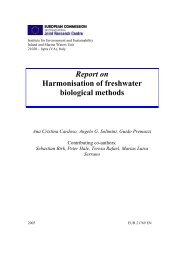Lakes and Watercourses
Lakes and Watercourses
Lakes and Watercourses
You also want an ePaper? Increase the reach of your titles
YUMPU automatically turns print PDFs into web optimized ePapers that Google loves.
Chlorophyll-a concentrations refer to seasonal means (May –<br />
October) over three years, based on monthly readings taken in the epilimnion<br />
or, if only one sample is taken, surface water (0.5 m). Alternatively,<br />
August readings taken over three years can be used, although<br />
account must then be taken of the relatively high variation from one year<br />
to another, particularly in eutrophic environments (class 4 <strong>and</strong> 5). The<br />
chlorophyll concentrations represent the intervals on the phytoplankton<br />
scale <strong>and</strong> the corresponding interval on the total phosphorus scale. The<br />
chlorophyll concentration has been assumed to constitute 0.5 per cent of<br />
plankton volume. Discrepancies in relation to the concentration of total<br />
phosphorus depend on lake depth, among other things.<br />
TABLE 27.<br />
CURRENT CONDITIONS: spring-developing diatoms (mm 3 /l)<br />
Class Description Biomass<br />
1 Very small biomass ≤ 0.05<br />
2 Small biomass 0.05 – 0.5<br />
3 Moderate biomass 0.5 – 2.0<br />
4 Large biomass 2.0 – 4.0<br />
5 Very large biomass > 4.0<br />
TABLE 28.<br />
CURRENT CONDITIONS: water-blooming cyanobacteria (mm 3 /l)<br />
Class Description Biomass<br />
1 Very small biomass ≤ 0.5<br />
2 Small biomass 0.5 – 1.0<br />
3 Moderate biomass 1.0 – 2.5<br />
4 Large biomass 2.5 – 5.0<br />
5 Very large biomass > 5.0<br />
The class boundaries have been set on the basis of the greatest<br />
biomass of diatoms occurring in corresponding classes for total volume<br />
of algae.<br />
53















![Accommodation booking form [PDF]](https://img.yumpu.com/39471785/1/184x260/accommodation-booking-form-pdf.jpg?quality=85)

